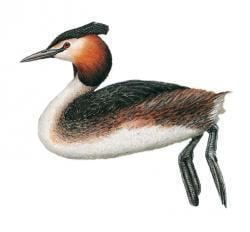Family Podicipedidae Phylum Chordata Rank Genus | Order Podicipediformes Scientific name Podiceps Higher classification Grebe | |
 | ||
Lower classifications | ||
Podiceps is a genus of birds in the grebe family. The genus name comes from Latin podicis, "vent" and pes, "foot", and is a reference to the placement of a grebe's legs towards the rear of its body.
Contents
It has representatives breeding in Europe, Asia, North, and South America. Most northern hemisphere species migrate in winter to the coast or warmer climates.
They breed in vegetated areas of freshwater lakes, nesting on the water's edge, since their legs are set too far back for easy walking. Usually two eggs are laid, and the striped young may be carried on the adult's back.
All the genus are excellent swimmers and divers, and pursue their fish prey underwater.
Adults have striking breeding plumage, with no difference between the sexes. In winter, the plumage is subdued whites and greys.
Bird of cyprus podiceps cristatus great crested grebe
Systematics
The black-necked, Colombian, silvery, and Junin grebes are very closely related and were formerly sometimes separated as the genus Dyas. The great grebe has also sometimes been separated as the sole member of the genus Podicephorus.
One of the very oldest fossil grebes known to date actually belongs to this genus. Regarding grebes, the fossil record leaves much to be desired, being quite complete for the last 5 million years before present but very incomplete before the Pliocene.
Fossil species of Podiceps are:
Among the material assigned to P. parvus were bones of another species, which may or may not belong in this genus.
